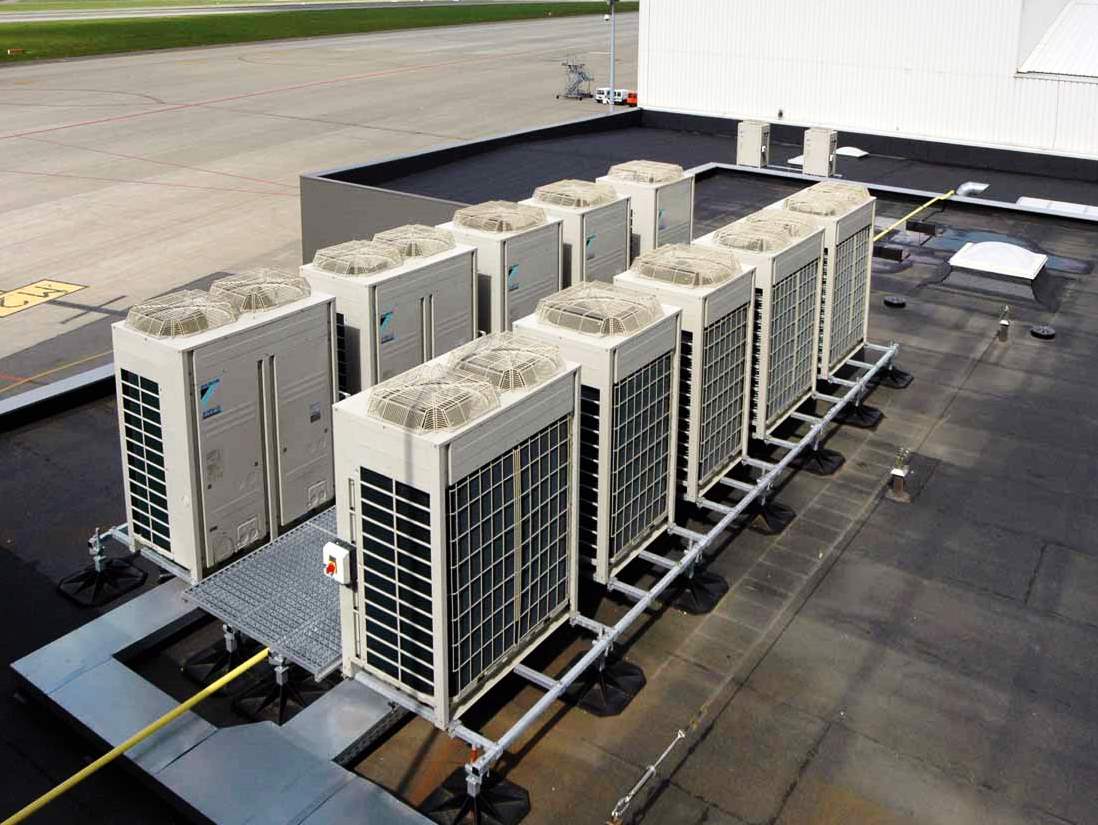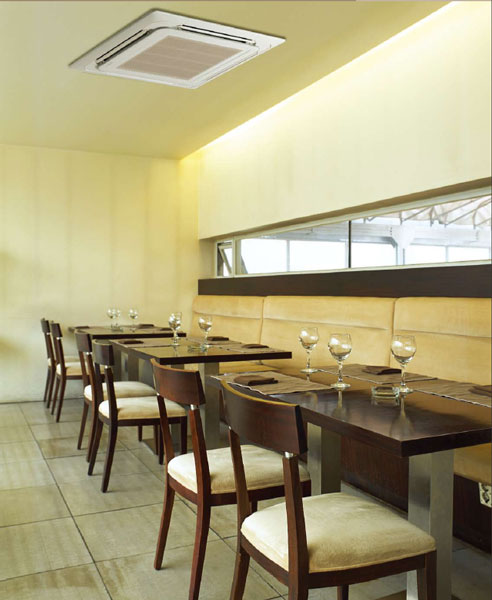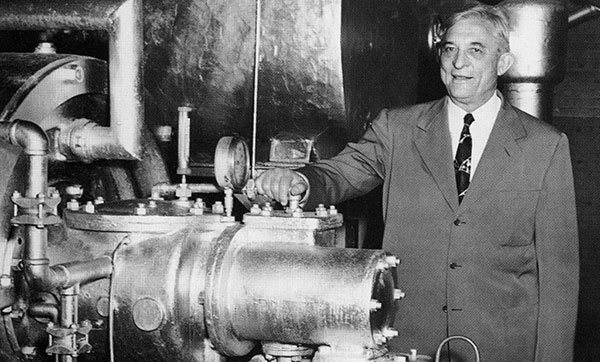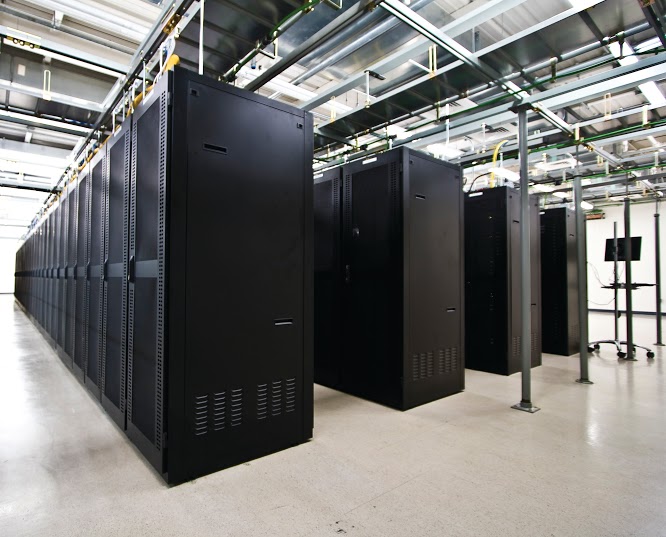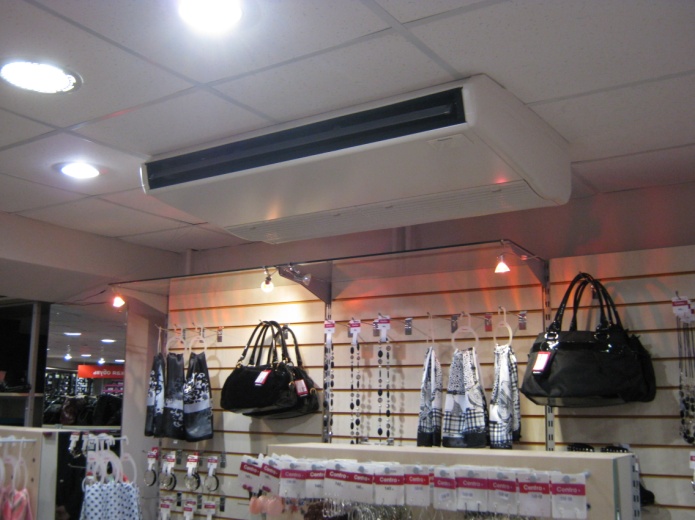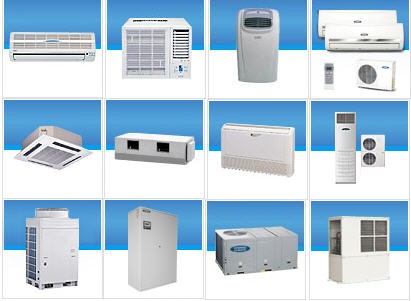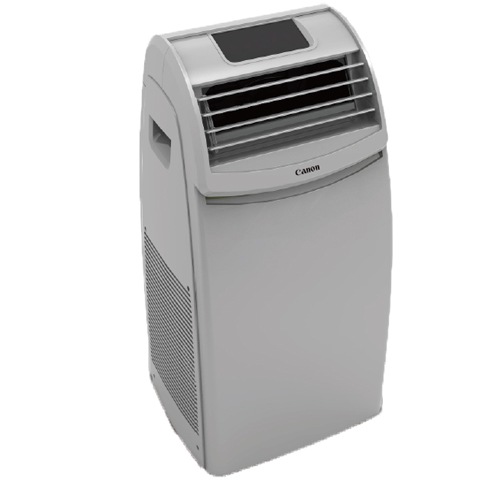A precision air conditioner is a device that not only cools or heats air, but also precisely maintains the values of several of its main parameters: temperature, humidity and mobility. Such units are classified as industrial equipment.
They find their application in rooms where it is required to create a suitable atmosphere for electronic equipment around the clock and year-round, and with maximum accuracy. Departure from the norm in temperature and humidity in most of these rooms is allowed by a maximum of 1 ° and 2%. Server rooms, rooms with telecommunications equipment, operating rooms in hospitals, research laboratories, burn centers and similar institutions require the installation of just such high-precision climatic equipment.
Types of precision air conditioners
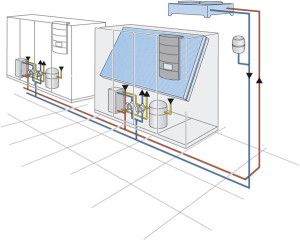
There are several types of such air conditioners. They can be divided relatively:
- constructions - monoblock, ceiling and precision cabinet-type air conditioners;
- condenser cooling type - air, water, mixed;
- number of contours - single-circuit and double-circuit devices;
- modifications (modes) - only cooling, cooling + humidification, cooling + heating, cooling + heating + humidification.
Monoblock units are suitable for small to medium sized rooms. They usually consist of a compressor, condenser and evaporator coils, condenser and evaporator fans, and an air filter. Their power rarely exceeds 20 kW, and they have the ability to change the direction of the air supply.
A cabinet-type air conditioner with a capacity of up to 100 kW helps to remove excess heat from equipment in larger rooms. Such a unit consists of one or two blocks - internal and external. The first contains all the elements of the refrigeration circuit, electrical components and automation. The external unit can be represented by a remote condenser, a compressor-condensing unit or a chiller (liquid cooler). They operate quietly and with a high level of precision.
Ceiling systems are also installed in small spaces. Their power varies on average from 3 to 20 kW. Neat dimensions allow them to be placed where there is no way to place a cabinet air conditioner. They can operate in natural and mixed cooling modes with little or no noise. Automatic protective algorithms prevent damage to the device, and in some devices the fan continues to work even after an accident. The control is usually carried out from the controller by means of integration with the dispatching system of the manned room.
How precision air conditioners work
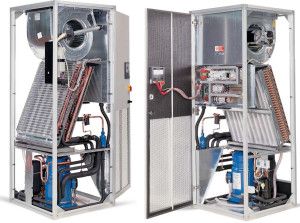
There are several principles of operation of precision air conditioners, depending on the type of cooling and the number of circuits.
Air cooled systems feature the most common refrigeration cycle, similar to that of a conventional split system. Freon is compressed under pressure in the compressor, and then enters the condenser, where it turns into a liquid state. From here, it passes through a thermostatic expansion valve (TRV), where its temperature is lowered.Getting into the evaporator, freon again turns into a gaseous state and enters the compressor again. In this case, the air is cooled as it passes through the evaporator and exits to the outside. The heat is removed from the condenser by a fan.
You can see the operation diagram of a precision air conditioner with a remote air condenser in this photo.
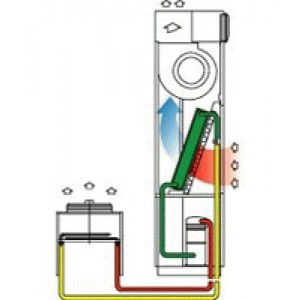
This principle of operation of precision air conditioners does not differ much from the cycle diagram of a device with a dry cooler. The difference is that the heat is discharged not through the fan, but into the water. A freon-water heat exchanger is installed in the indoor unit, to which an external (dry cooler) with a water pump is connected. It is through the heat exchanger that heat is transferred, and it is discharged to the street thanks to the fan of the outdoor unit.
If the air conditioner is water-cooled, then it is usually combined with a chiller. In the indoor unit, the air is cooled by a refrigerant that lowers its temperature in the liquid cooler.
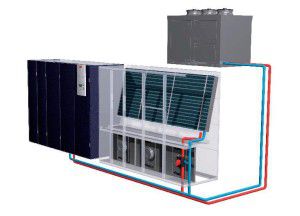
This photo shows a diagram of the operation of a precision air-conditioner with water cooling through a chiller.
For precision air conditioners with a double circuit, a different principle of operation is characteristic, in which air from the servers enters the evaporator of the indoor unit of the precision air conditioner and is cooled there, from there it already goes into the room. The heat load removed in this way is transferred to a condenser built into the internal unit of the device and cooled with water, and then released into the water circuit. From here the heat is released with a dry cooler and discharged into the atmosphere.
Air supply and intake

The intake and delivery of air from precision air conditioners can also take place according to different schemes:
- bottom fence / top delivery;
- top fence / bottom delivery;
- fence from the front / top delivery.
If the air outlet is from the top, then it passes through the upper panel of the device; at the lower outlet, a raised floor is usually installed, through the air distribution space of which air is dispensed.
type of instalation
There are indoor and outdoor precision air conditioners. The former are used when it is necessary to integrate the device into an existing system or when there is a lack of space in the room. This is a very economical air conditioning option as a standard outdoor air conditioner has the option of free cooling using outdoor air.
As a rule, these are monoblock systems that can be controlled remotely or by a thermostat.
Internal installation is typical for cabinet and ceiling precision machines. During installation, two holes are cut for them, through one of which the condenser will be cooled.
If the device is mounted from the street side, then two holes are also cut during installation. Air will pass through one of them to cool the room, and through the second, the waste will be taken from the room. When installed outdoors, fresh air is added at a low temperature, and thus the air conditioner works by free cooling, the so-called FREE COOLING.
Installation of precision air conditioners
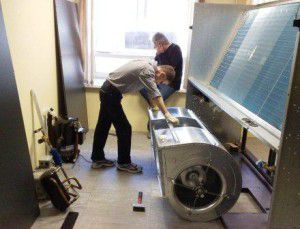
The installation of any precision air conditioner requires detailed planning and a lot of experience from the craftsmen. It takes place in several stages:
- Selection of a place for installation, taking into account the location of heat sources, surrounding objects and protective mechanisms (visor and grilles). The allowable route length and height differences between blocks are taken into account.
- Reliable fastening of the outdoor unit to the brackets, taking into account vibrations during operation. Be sure to leave access to the module for maintenance.
- Reliable fastening of the indoor unit, taking into account the distance from heat sources and other objects in the room. Provide space for normal air circulation. The tilt of the module is allowed no more than 5%.
- Laying interblock communications. Holes are drilled in the wall through which the drain hose, freon line and electrical cables will pass. If it is necessary to exceed the permissible line length and height differences, it is necessary to install trap loops on the pipeline in order to reduce the load on the compressor. They monitor the high-quality sealing of the route and the insulation of cables. All communications are packed in special pipes and vinyl tape, and then pulled through the holes in the wall.
- Connection of a precision air conditioner according to the electrical diagrams, which are given in the technical passport, and are also marked on both blocks.
- The last stage is the evacuation of the system and a trial run of the installation.
It is worth remembering that some precision devices have humidification systems that require separate adjustments.
Maintenance of precision air conditioners
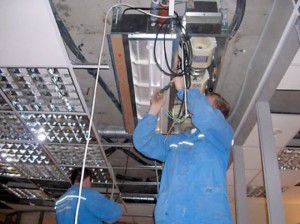
Regular maintenance of precision air conditioners, which is carried out at least once a quarter, plays an important role in trouble-free operation. The frequency depends on the location of the device and the level of its load. What is included in preventive measures?
Standard service work includes diagnostics for faults and cleaning / replacement of some elements. Diagnostics consists of:
- checking the condition of the inter-unit route and electrical communications;
- testing of operating modes;
- measurements of the compressor current, the level of freon in the circuit and the output air parameters.
Preventive work consists of:
- checking the condition and, if necessary, cleaning the heat exchangers, fans, filters and the front of the air conditioner;
- replacement of filter elements and steam cylinder.
If during the maintenance of the precision air conditioner malfunctions are revealed, then repair and restoration work may be required to replace its damaged components and mechanisms.
Popular brands in Russia
The most popular and demanded brands of precision air conditioners in Russia are UNIFLAIR, LIEBERT, EMERSON and BLUE BOX.
UNIFLAIR
The Italian company UNIFLAIR produces several series of very compact monoblock, ceiling and cabinet-type devices for both indoor and outdoor installation. Their power ranges from 3.9 to 168.7 kW. Among them there are devices with air, water and natural cooling. TWIN-COOL models have a double cooling circuit. The air is blown out from the front, from above through the air ducts or suspended ceiling and from below through the raised floor. There are series with free cooling function.
All UNIFLAIR precision air conditioners are energy efficient machines that can operate even at extremely low outdoor temperatures (down to -40 ° C).
Maintaining normal humidity and temperature levels is accurate to within 2% and 1 ° C, respectively.
The equipment works seamlessly with smoke, fire and water leakage detectors. It is combined with building microclimate control systems. The average continuous service life of the UNIFLAIR precision air conditioner is 10-15 years. These are robust chillers ideal for archives, museums, healthcare facilities, telephony centers, server rooms and control rooms.
LIEBERT & EMERSON GROUP
Another world leader in the HVAC equipment market is LIEBERT precision air conditioners (EMERSON), which are able to maintain the set parameters with an accuracy of tenths of degrees and percent.
Several decades ago, two companies LIEBERT and EMERSON merged and began to produce climatic equipment for industrial facilities. Precision air conditioners EMERSON, LIEBERT HIROSS operate at extreme temperatures in summer and winter and, if the operating conditions are observed, they can last from 10 years in continuous mode. Power variability - from 3.5 to 160 kW.
The company produces a separate line of air modules with a rating of 1.2 kW.These mini machines are adapted for installation on the door or wall of electronic cabinets.
Several product lines are represented by cabinet monoblocks and two-component systems for indoor and outdoor installation with air, water and natural cooling of the condenser. The most efficient and economical models are LIEBERT precision air conditioners with two refrigerants and backup compressors. Management is carried out by a modern controller with access to a computer network.
Most units have an emergency fan operation until troubleshooting.
The main part of EMERSON, LIEBERT HIROSS precision air conditioners has wide monitoring capabilities and high versatility due to several connection options at objects of completely different configurations.
BLUE BOX
Another Italian company BLUE BOX has established itself in the Russian market as a competitive manufacturer of precision air conditioners and other industrial refrigeration systems.
High-precision equipment is produced in monoblock and separate versions, with air coolers of air, water and mixed types, as well as with built-in and remote condensers with water or air cooling. The power of BLUE BOX precision air conditioners varies from 6.4 to 220 kW.
The main parameters of the indoor air are maintained with maximum accuracy to tenths of degrees and percent. The compactness is compatible with excellent performance and energy efficiency. The latest technologies in the fan and compressor design allow to produce units with a minimum noise level and air consumption.
BLUE BOX manufactures precision air conditioners that operate in all possible modes. Powerful shut-off valves and automatic safety systems prevent serious accidents. All devices operate on modern brands of freon that do not contain chlorine.
To choose the right model of a precision device, first of all, they pay attention to the air distribution system, the availability of the required operating modes, the accuracy of maintaining the air parameters and the range of operating temperatures for winter and summer.
Only a specialist can fully calculate the power and the necessary modification.

